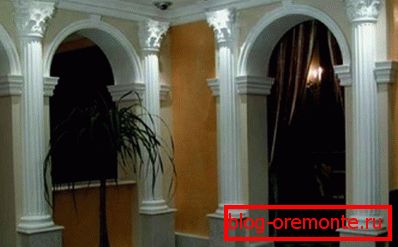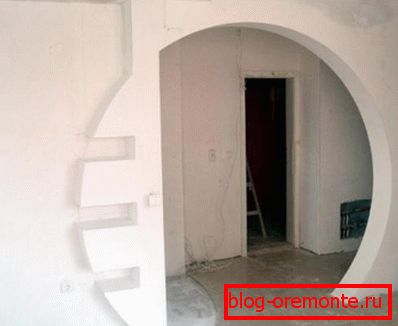Arch do it yourself - an original solution for the interior
Among the many design solutions to make the house more comfortable, the arches are not the last. The arch can be made in classical style, in modern style or in ellipsoid style. What style to choose and how the arch can be made with your own hands, we will tell in this article.
Ready openings

Arched forms have become so popular today (see Arches in the interior), that the installation of the arch with your own hands is not mandatory. You can buy a ready-made solution to this issue. The kit will include two arcs of the desired bend radius, four racks and a set of panels designed for locks and racks.
As a rule, the arch of the MDF do not do it yourself. This material is more often used for finished openings. Such arches are used for almost all door and window openings up to one and a half meters wide and up to two and a half meters high.
In general, arched structures can be made from many materials, including concrete, plasterboard (see Making an arch out of plasterboard — detailed instructions), brick, and wood. However, some materials, such as drywall or wood, can only be used indoors, free from excess moisture.
Brick construction
Arch in the apartment with his own hands can be made of brick. First you need to decide why you need this design. As a rule, a brick is used when an arched type jumper is planned, and its width will be more than two meters.
To perform the brickwork will need a formwork of a certain shape. It is for this formwork will be arched masonry.
All formwork elements will be mounted using screws and wedges, which will dismantle the formwork at the end of the work, without damaging the brickwork.
Tip! In order that the arch masonry has seams of the same thickness, a brick of a special curved type with different width of the end parts is used for its construction.
If an arch brick is used in an arched structure, then the individual seams of the masonry, which are on the rounding, will have a wedge appearance, which may be unattractive. The advantages of brickwork include the fact that any radius of curvature can be made in this design.
Wooden arches
The arch from a tree with own hands or from plywood uses wide enough popularity. To make such a need for the presence of special glued blocks, fastened to each other by rigid joining.
There are several options for mounting such arches without the need to use puffs, where fasteners are an emphasis on the posts of the structure. Note that this mounting option glued blocks is applicable only for narrow openings, where there is no high load on the carrier rack.
In some cases, you can make rotary parts of a wooden structure from a single piece of wood, cutting according to a previously prepared template. The wooden arched design is not always strong in structure, since if the bend passes through the fibers of the wood, even small loads can lead to splitting of the wooden material.
However, there is a rational way of bending the wood: the wooden billet is boiled or steamed in a special form, as a result of which the desired shape becomes after drying. The most reliable is the way in which multi-layer gluing of wood is carried out - thin wooden pieces are glued to the desired arched structure.
Then the design is processed with a special tool. The method makes it possible to give the desired shape and bend radius to the arch, which can take on significant loads.
Despite the strength and attractiveness of glued arched construction, for its construction requires a lot of time and effort, as well as the presence of a special tool.
Drywall arch
Arched opening of this type are considered the most common and inexpensive. As a rule, they are located in those places where you can do without entrance doors.
Making arches with your own hands in such a variation does not require a special tool and considerable experience in working with plasterboard.
Interior arches do it yourself most often made of plasterboard (see Arch of plasterboard). To make a plasterboard arch opening, you need a tool such as a screwdriver and a construction knife.
Preparatory work

Do-it-yourself installation of interior arches begins with drawing up an accurate design drawing, which will include the bend radius and all dimensions. Then the surface of the partition itself is prepared. If the opening is done at the same time as the partition, the work will go much faster and easier.
If there is a need to make an arched opening in the already finished plasterboard partition, then the partition will need additional hardening with a wooden bar or metal profile. Thus, the prepared opening will be strengthened by the supporting frame, taking into account all the attachment points of the drywall blanks.
Bending plasterboard and profile
The most crucial moment in the creation of the opening from the drywall is the bending of blanks from the drywall and the metal profile. There are ready-made variations of such bends, but their cost is high, given the fact that the independent production of the elements of bending is not difficult.
So, do it yourself. We will need metal shears.

The sequence of work:
- It is not necessary to cut off the ideally accurate profile length before bending, since if the workpiece is bent, then it is easy to err in the calculations. It is better to let the billet be an order of magnitude longer, since cutting is much simpler than building a profile web.
- With the help of scissors for metal we make cuts in steps of thirty millimeters. The presence of these cuts will help us to bend the profile along any radius without fearing that we will get a sharp bend angle. Then we prepare and trim to the exact size and fasten the blanks in the doorway, while trying to make the frame structure as rigid as possible.
- Getting down to bending the drywall blank. There are two main ways of bending drywall: raw and patterned. Both methods are practical and simple. However, the template is considered longer. So, we took the drywall strip you need length and width. If you bend a dry workpiece, it will necessarily burst, since it consists of two cardboard layers and a gypsum core. In order for the gypsum core to become plastic, it needs to be wetted. Do not allow the ripping of the layers of cardboard, because they play the role of a gypsum-retaining element.
- Put the drywall blank on a hard and flat surface upwards with the side to be bent.
- Next, we make in the cardboard layer and the gypsum core punctures with a depth of about 2-3 millimeters. For punctures use a needle roller. This roller is an ordinary plastic roller, with a surface dotted with small needles intended for puncturing gypsum and cardboard. This tool is not cheap, and you can do without using it. To do this, you can pierce drywall with a simple screw on a tree that has a sharp tip.
- Following the piercing of drywall, you need to wet the pierced surface with plenty of water, not letting the opposite layer of cardboard get wet.
- After gaining sufficient elasticity with the gypsum core, we fasten the billet to the prepared frame with screws. This is the main difference between the two variants of the drywall bend, so using the template method, before fixing the workpiece at the base, you will need to strengthen it in the prepared template and allow it time to dry.
Video on the topic.
Concrete arches
Highlights:
- The monolithic reinforced arch can be used for the street.Because this material is not afraid of the weather.
- Before making, they think over and write down the required dimensions of the structure.and then make solid formwork. For this formwork, an edging board is used - this makes it possible to manufacture a flat arched structure.
- The design must be properly reinforced, because the concrete itself is not reliable enough. The reinforcement cage is located inside the structure, not reaching the arched walls.
- Concrete solution for pouring into the prepared formwork is prepared according to the standard recipe, the same as for the production of foundation structures. Proportion of the mortar: one part of cement M400, three parts of sand that does not contain clay, five parts of fine crushed stone or medium-sized gravel. During the manufacture of such a structure, it is necessary to carefully monitor the purity of the material, as this will affect the strength of the finished structure.
So, as you can see, there are a sufficient number of types of arches, both external and internal. To choose the right type of arch and the material for its manufacture, you will need to decide on the construction budget and the purpose of the structure.